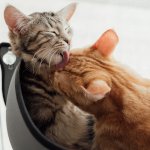National Hairball Awareness Day Date in the current year: April 24, 2026
 National Hairball Awareness Day is observed annually on the last Friday of April. Primarily targeted at cat owners, it was created to raise awareness of trichobezoars and educate the general public on their prevention.
National Hairball Awareness Day is observed annually on the last Friday of April. Primarily targeted at cat owners, it was created to raise awareness of trichobezoars and educate the general public on their prevention.A hairball is a type of bezoar, or a mass found trapped in the gastrointestinal system. As the name suggests, it is composed of hair. Trichobezoars are uncommon in humans, except for people with disorders that cause them to ingest hair such as compulsive hair eating (trichophagia) and chronic hair puling (trichotillomania). They can result in an extremely rare condition called Rapunzel syndrome, in which the body of a trichobezoar is located in the stomach, and its tail reaches into the bowel.
Hairballs are much more common in animals, especially those that groom themselves by licking their fur, such as cats and rabbits, and cud-chewing animals (cattle, goats, deer, sheep). Hairballs in cats aren’t typically a cause for concern because cats would vomit them up when they become too big. However, rabbits and cattle cannot regurgitate them.
Trichobezoars are especially dangerous for rabbits because rabbits have a very fragile digestive tract and may stop eating and drinking if hairballs are left untreated. Cattle with trichobezoars eat little grass, drink lots of water, and become emaciated. Hairballs in cattle can be quite large and are typically found after death.
Even though hairballs are, to some extent, a normal occurrence in cats, they can create an obstruction in the digestive tract if not passed properly. This is why every cat owner should adhere to these tips if they want their cat to be healthy and happy:
- Groom your cat regularly and properly to reduce the amount of hair it ingests while grooming itself. Brush or comb your cat every day and take it to a professional groomer (especially of you have a long-haired cat) at least twice a year.
- Make sure your cat’s diet includes enough fiber to prevent hairballs from getting stuck in the digestive tract. However, too much fiber can be bad for your cat so don’t go overboard.
- Check with your vet if your cat is prone to excessive grooming.
- Immediately bring your cat to a vet if it is experiencing any of these symptoms: repeated gagging, retching or vomiting without producing a hairball, constipation or diarrhea, appetite loss, weight loss, lethargy.
National Hairball Awareness Day was created by the National Museum of Health and Medicine (NMHM) in Silver Spring, Maryland. The NMHM launched it to explore the myths and realities behind trichobezoars and draw attention to its collection of veterinary and human hairballs, which, alongside cat hairballs, includes hairballs from a chicken, a horse, a calf, a steer, two oxen, and three cows.
Since its inception, National Hairball Awareness Day has gained the support of various veterinary organizations and clinics, both in the United States and abroad (there are mentions of this awareness day being observed in the United Kingdom). From simply exploring trichobezoars as a medical curiosity, its focus has shifted toward educating pet owners about hairballs and their possible dangers, and sharing tips for preventing hairballs.
- Category
- Ecological Observances
- Country
- USA, United Kingdom
- Tags
- National Hairball Awareness Day, environmental observances, animal holidays, holidays in the US, holidays in the UK